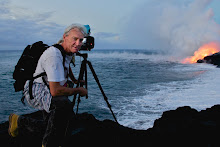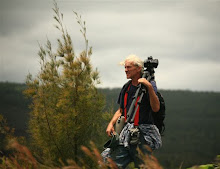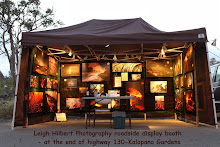 Above: A splice of the three Jaggar Museum crater cam images from yesterday afternoon, and below, the same cam view at 10:00 PM last night.(click on them for larger szes)
Above: A splice of the three Jaggar Museum crater cam images from yesterday afternoon, and below, the same cam view at 10:00 PM last night.(click on them for larger szes)
At 2:58 a.m. H.s.t on Wednesday, March 19, 2008, an explosion occurred on the floor of the Halema`uma`u Crater at the summit of Kilauea Volcano in Hawai`i Volcanoes National Park; the first explosion since 1924, the first eruptive activity since 1982. Geologists at the time speculated the blast was a result of either hydrothermal magma thrust or intense pressurized gas sources.
 The resulting hole spewed sulphur dioxide heavily - jumping from the usual 150-metric tonnes per day to 1000, which continues today at varying high amounts. The size of the original blast hole was about 160-feet across. The edges of the raw new vent opening have collapsed many times, increasing the diameter to something like 480-feet over the past two and a half years (Going by memory for those diameters).
The resulting hole spewed sulphur dioxide heavily - jumping from the usual 150-metric tonnes per day to 1000, which continues today at varying high amounts. The size of the original blast hole was about 160-feet across. The edges of the raw new vent opening have collapsed many times, increasing the diameter to something like 480-feet over the past two and a half years (Going by memory for those diameters).These rockfall events - the vents edges dropping off - often create violent explosions that are witnessed by viewers and also recorded on the two crater cams aimed at the crater.
Here is one of those events:
 Molten lava broils in the bottom of this crater-within-a-crater at around 600-foot below the main crater floor, though this main base level fluctuates regularly, and at times changes level sporadically; rising upwards over a hundred feet before dropping back to near its previous levels.
Molten lava broils in the bottom of this crater-within-a-crater at around 600-foot below the main crater floor, though this main base level fluctuates regularly, and at times changes level sporadically; rising upwards over a hundred feet before dropping back to near its previous levels.  These USGS/HVO crater overlook cam images are from their images page here
These USGS/HVO crater overlook cam images are from their images page here Geologists refer to these events as high-stands. High stands temporarily, but drastically, alter the sulphur dioxide rates and can cause the plume to become very thin and wispy. Another result of a high-stand event are changes to the intensity of the broiling lava inside the vent, which can become dimmer and much brighter as the event unfolds.
Geologists refer to these events as high-stands. High stands temporarily, but drastically, alter the sulphur dioxide rates and can cause the plume to become very thin and wispy. Another result of a high-stand event are changes to the intensity of the broiling lava inside the vent, which can become dimmer and much brighter as the event unfolds.
Just two weeks prior to the Kilauea crater event of March 16th, 2008, molten lava from the 2007 TEB eruption site, just east of Pu`U O`o crater, found its way down the Pulama Pali and had begun entering the ocean at Waikupanaha, which was to become our big coastal lava entry display for the next twenty months, ending January 3rd this year.

This and other information on the history and ongoing activity of Kilauea can be found on the many USGS/HVO informative links.
~~~~~~~~~~~~~~~~~~~~~~~~~~~
Lava continues pouring into the ocean near Kalapana Gardens.
There are no surface flows on the coastal flats reported at this time.
Also-- Tonight, if skies are clear, look for the planet Jupiter next to the nearly full moon; Jupiter will be at its closest point to earth than it will be again until 2022.
~~~~~~~~~~~~~~~~~~~~~~~~~~~
Both Halema’uma’u and the coastal ocean entry visitor sites (Click on the highlighted text for more information) have good viewing of the ongoing eruption.
I will add updates when I can, or when significant changes to the volcanic eruption take place…. Or, of course, any other exciting stuff is heading towards the islands like super ocean swells, tsunamis or hurricanes…
~ Aloha,
Leigh










No comments:
Post a Comment